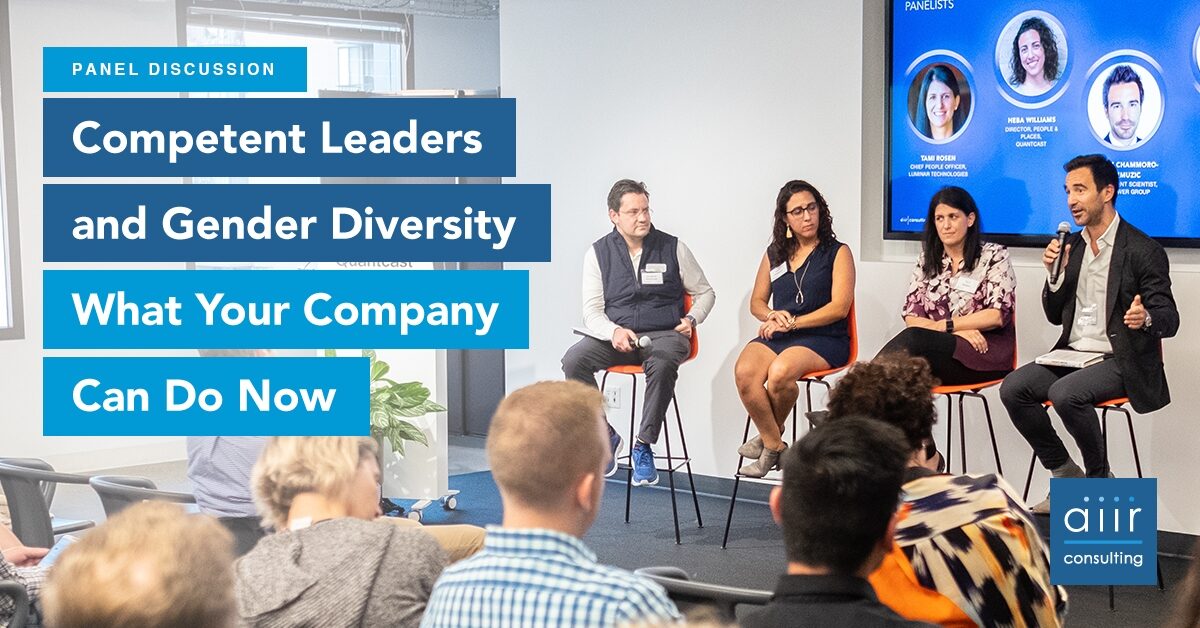
Competent Leaders and Gender Diversity: What Your Company Can Do Now
Diversity & Inclusion Experts Break Down a Complicated Problem
At a recent AIIR San Francisco event, a panel of top Diversity & Inclusion experts discussed the hot topic of of gender representation in leadership. The discussion featured panelists Tami Rosen (Chief People Officer, Luminar Technologies), Heba Williams (Director, People and Places, Quantcast), and Dr. Tomas Chamorro-Premuzic (Chief Talent Scientist, Manpower Group). AIIR CEO, Dr. Jonathan Kirschner, served as moderator for the event.
The panelists offered valuable insights into how their organizations are making the effort to increase gender balance and develop more female leaders. You can watch the discussion below, or keep scrolling for three key takeaways.
Three Things Your Company Can Do Now
1. For better diversity and inclusion, start with reshaping the basics.
Tami Rosen, Chief People Officer at Luminar Technologies, explained that, to increase diversity and inclusion in its recruitment process, Luminar Technologies started with fundamentals. From the conscious choice of language to the use of gender-neutral terms, Rosen and her team reshaped their recruitment process to be more objective. They were also able to shift Luminar’s culture to be more conscious of gender diversity and identity.
The event included time for networking and a Q&A session that sparked lively discussion between the attendees and the panelists.
2. Achieve better D&I outcomes by focusing on quality candidates over quantity
Heba Williams, Director, People and Places at Quantcast, said efforts to recruit more women or include a greater number of women into a company’s leadership pipeline often miss the point. Rather than setting quantitative goals around diversity and inclusion, companies should work to ensure that they are attracting and identifying the highest quality candidates. Once identified, those leaders need to be placed where they can do the greatest good. For example, technology and engineering roles tend to bias toward men, even when there is a pool of high-quality female candidates. Rather than simply seeking to increase the number of women in technology and engineering roles, companies should be working to ensure that they work to identify the best candidates for the role, many of whom will be women.
Dr. Kirschner (right) and Dr. Chamorro-Premuzic posing with copies of Why Do So Many Incompetent Men Become Leaders? (And What To Do About It).
3. Recognize the differences between technical skill and leadership skills
According to Dr. Chamorro-Premuzic, Chief Talent Scientist at Manpower Group and member of the AIIR Advisory Board, there are those who possess hard skills and technological expertise that make them high-performing individual contributors and those who have the skillset to manage those individual contributors. By making technological expertise a prerequisite for promotion, companies risk both losing a valuable individual contributor and creating an under-performing manager.
“What you need as a leader is emotional intelligence, people skills, integrity, coachability, self-control, and self-awareness,” he said. “Select on these traits and you have more women than men.”
And, he stresses, “If men can’t be managed or lead by women, you don’t want [those men] in your organization.”
After the event, panelists and attendees enjoyed a cocktail reception on the Quantcast roof.
“There’s a difference between an individual contributor who needs technical expertise…and people who can manage and lead individual contributors.”
Tomas Chamorro-Premuzic
All of the panelists agreed that the prevalence of conversations about gender diversity and inclusion like the panel discussion has created visible progress and hope for change.
“If you innovate around the norm, you’ll include,” Rosen said. “Then you’ll get more differences around the table.”
About Our Gender Diversity and Inclusion Panelists



Are You Ready To Shape A Better Future Together?
Partner with AIIR to empower your leaders and ascend into the future.